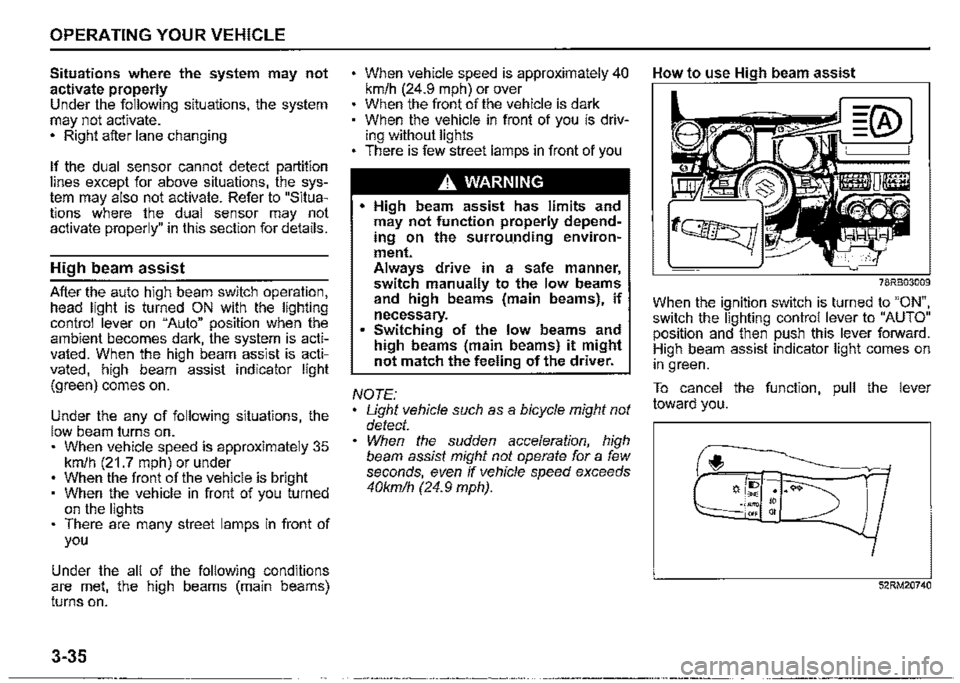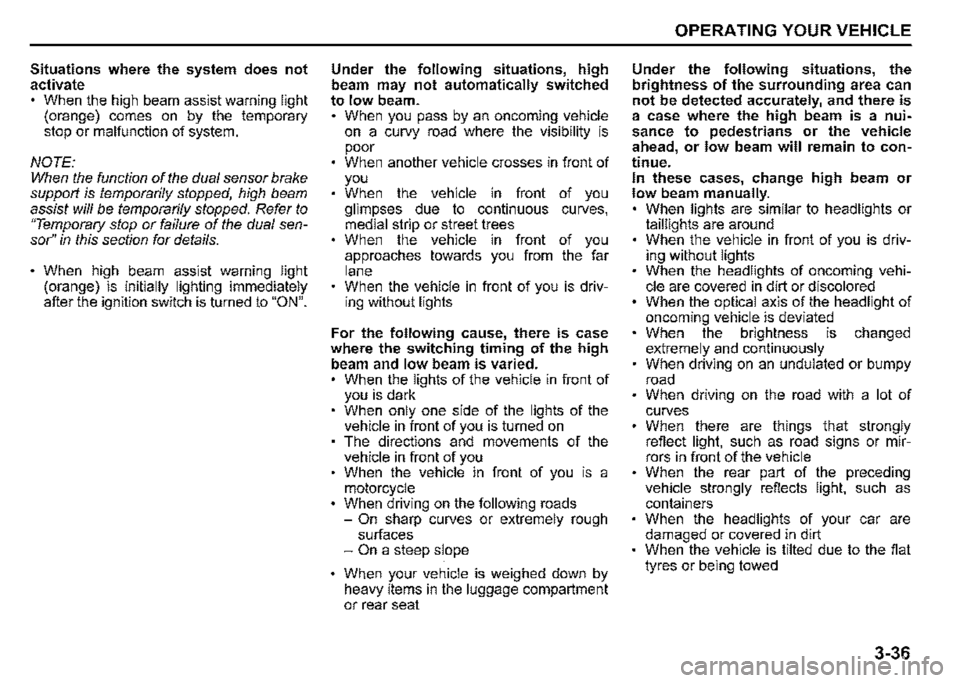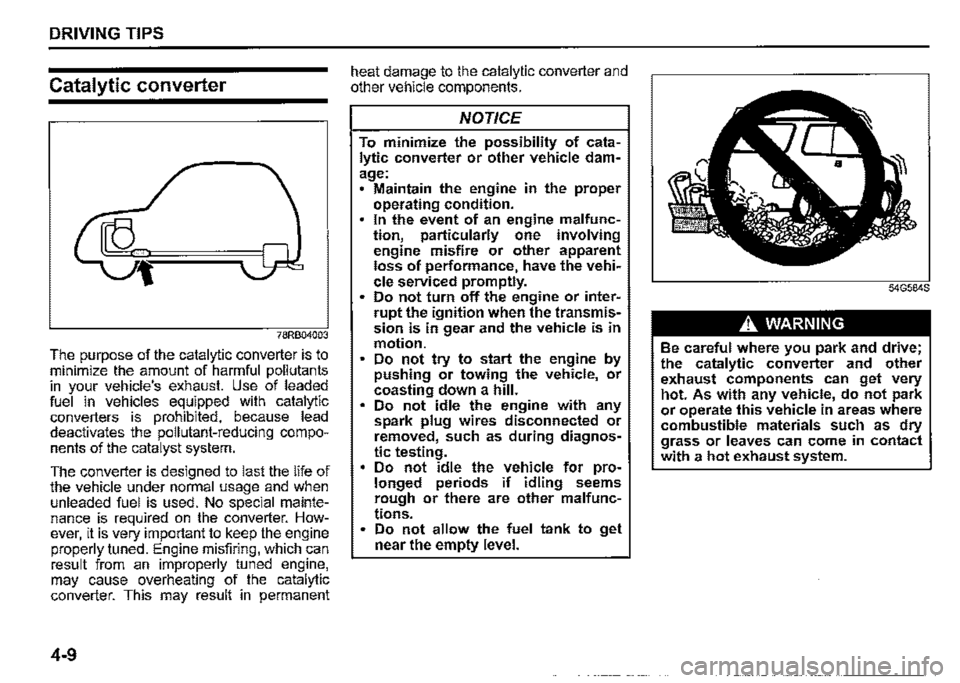tow SUZUKI JIMNY 2020 Owner's Manual
[x] Cancel search | Manufacturer: SUZUKI, Model Year: 2020, Model line: JIMNY, Model: SUZUKI JIMNY 2020Pages: 421, PDF Size: 6.35 MB
Page 171 of 421

NOTICE
Pay attention to shifting the transfer lever safely when driving your vehicle.
NOTE: After shifting the transfer lever from "2H'" to "4H", check that the 4WD indicator
light comes on. After shifting the transfer lever from "4H" to "2H", check that the 4WD indicator goes off. ·
When 4WD indicator fight is blinking after shifting the transfer fever to "4H" position, accelerate, slow down your vehicle or stop and reverse your vehicle a little to shift the transfer lever. Pay attention to the vehicles and the circumference toward or backward your vehicle when shifting the transfer fever. When you shift the transfer fever while turning the steering wheel or depressing the accelerator pedal, shifting the transfer fever may be difficult. Operate the transfer fever while driving at low speed if it may be difficult to shift the transfer fever from "2H" position to "4H" position when the vehicle is stopped.
Shift the transfer fever again after decelerating or stopping the vehicle if it may be difficult to shift the transfer fever from "2H" position to "4H" position while driving or when the gear noise occurs. There may be a case to operate the transfer fever heavily when shifting the transfer lever from "4H" position to "2H" P_Osition while driving. In this case, position the front wheels straight ahead and drive for a while and then operate shifting the transfer fever again. When the transfer lever is shifted from 2H" position to "4H" position or from "4H" position to 2H" position and the air locking hubs are activated, the air conditioning system may not be operated for several seconds. This is not a malfunction. When the ignition switch is turned "ON" after the transfer fever is shifted from 2H" position to "4H" position or from "4H" position to 2H" position while stopping the engine, 4WD indicator light may blink. This is not a malfunction.
OPERATING YOUR VEHICLE
78RB03027
Stop the vehicle completely, place the transmission in "N" (Neutral) or depress the clutch pedal fully (if equipped), then shift the transfer lever from "4H" position to "4L" position by pressing the transfer lever.
3-20
Page 183 of 421

Brake assist system Under the followings and there is a high probability of a frontal collision, the brake assist system provides more powerful braking when you slam down on the brake pedal. When you are operating at speeds between approximately 15 km/h to 80 km/h (9 mph to 50 mph).(For pedestrian, operating speed is between approximately 15 km/h to 60 km/h (9 mph to 37 mph).) The relative speed between your vehicle and the vehicle or pedestrian ahead is approximately 15 km/h (9 mph) or more.
When the brake assist system activates, the frontal collision warning also activates at the same time.
Automatic brake system Under the followings and a frontal collision is judged to be unavoidable, the brakes will powerfully operate automatically. When you are operating at speeds between approximately 5 km/h to 100 km/h (3 mph to 62 mph).(For pedestrian, operating speed is between approximately 5 km/h to 60 km/h (3 mph to 37 mph).) The relative speed between your vehicle and the vehicle or pedestrian ahead is approximately 5 km/h (3 mph) or more.
When the automatic brake system is activated at a speed of approximately 50 km/h (31 mph) or under toward the vehicle in front of you (or toward the pedestrian, approximately 30 km/h (19 mph) or under), collisions may be avoidable.
While the automatic brake system is activating, the interior buzzer will continuously beep, the dual sensor brake support indicator light will blink rapidly, the indication on the information display will appear, and the brake lights will come on.
OPERATING YOUR VEHICLE
D
78RB03035
NOTE: The indication on the information display and the dual sensor brake support indicator light will go off after approximately 3 seconds after the automatic brake system is released.
3-32
Page 186 of 421

OPERATING YOUR VEHICLE
Situations where the system may not activate properly Under the following situations, the system may not activate. • Right after lane changing
If the dual sensor cannot detect partition lines except for above situations, the system may also not activate. Refer to "Situations where the dual sensor may not activate properly" in this section for details.
High beam assist
After the auto high beam switch operation, head light is turned ON with the lighting control lever on "Auto" position when the ambient becomes dark, the system is activated. When the high beam assist is activated, high beam assist indicator light (green) comes on.
Under the any of following situations, the low beam turns on. • When vehicle speed is approximately 35 km/h (21.7 mph) or under When the front of the vehicle is bright When the vehicle in front of you turned on the lights There are many street lamps in front of you
Under the all of the following conditions are met, the high beams (main beams) turns on.
3-35
When vehicle speed is approximately 40 km/h (24.9 mph) or over When the front of the vehicle is dark When the vehicle in front of you is driving without lights • There is few street lamps in front of you
A. WARNING
• High beam assist has limits and may not function properly depending on the surrou.nding environment. Always drive in a safe manner, switch manually to the low beams and high beams (main beams), if necessary. Switching of the low beams and high beams (main beams) it might not match the feeling of the driver.
NOTE: Light vehicle such as a bicycle might not detect. When the sudden acceleration, high beam assist might not operate for a few seconds, even if vehicle speed exceeds 40kmlh (24.9 mph).
How to use High beam assist
78RB03009
When the ignition switch is turned to "ON", switch the lighting control lever to "AUTO" position and then push this lever forward. High beam assist indicator light comes on in green.
To cancel the function, pull the lever toward you.
f,
52RM20740
Page 187 of 421

Situations where the system does not activate When the high beam assist warning light (orange) comes on by the temporary stop or malfunction of system.
NOTE: When the function of the dual sensor brake support is temporarily stopped, high beam assist will be temporarily stopped. Refer to "Temporary stop or failure of the dual sensor'' in this section for details.
When high beam assist warning light (orange) is initially lighting immediately after the ignition switch is turned to "ON".
Under the following situations, high beam may not automatically switched to low beam. When you pass by an oncoming vehicle on a curvy road where the visibility is poor When another vehicle crosses in front of you When the vehicle in front of you glimpses due to continuous curves, medial strip or street trees When the vehicle in front of you approaches towards you from the far lane When the vehicle in front of you is driving without lights
For the following cause, there is case where the switching timing of the high beam and low beam is varied. When the lights of the vehicle in front of you is dark When only one side of the lights of the vehicle in front of you is turned on The directions and movements of the vehicle in front of you When the vehicle in front of you is a motorcycle When driving on the following roads -On sharp curves or extremely rough surfaces -On a steep slope
When your vehicle is weighed down by heavy items in the luggage compartment or rear seat
OPERATING YOUR VEHICLE
Under the following situations, the brightness of the surrounding area can not be detected accurately, and there is a case where the high beam is a nuisance to pedestrians or the vehicle ahead, or low beam will remain to continue. In these cases, change high beam or low beam manually. When lights are similar to headlights or taillights are around When the vehicle in front of you is driving without lights When the headlights of oncoming vehicle are covered in dirt or discolored When the optical axis of the headlight of oncoming vehicle is deviated When the brightness is changed extremely and continuously When driving on an undulated or bumpy road When driving on the road with a lot of curves When there are things that strongly reflect light, such as road signs or mirrors in front of the vehicle When the rear part of the preceding vehicle strongly reflects light, such as containers When the headlights of your car are damaged or covered in dirt When the vehicle is tilted due to the flat tyres or being towed
3-36
Page 188 of 421

OPERATING YOUR VEHICLE
Other than the described above, the dual sensor cannot be detected the vehicle in front of you or light source, and there is a case where high beam assist may not activate properly. Refer to "Situations where the dual sensor may not activate properly" in this section for details.
Under the following situations, switch high beam or low beam manually, When switching back and forth between the high beams (main beams) and low beams frequently When there is a problem using the high beams (main beams) When it is considered disturbing to other drivers or pedestrians
There is a case where high beams (main beams) is switched to low beams by the fog lights of the vehicle in front of you.
Street lights, traffic signals, and illumination of billboards or signs may cause the high beams (main beams) to switch to the low beams, or low beam to remain on.
3-37
Dual sensor brake support OFF switch
You can turn off the dual sensor brake support system. In the following situations, push and hold the dual sensor brake support OFF switch as unexpected dangers may be possible if ii is activated. -When the vehicle is placed upon atester such as when undergoing a vehicle inspection -When the vehicle is put up on a lift, and the tyres are idling -When the vehicle is being towed -When the vehicle is being carried on a car carrier -When the vehicle is being operated on a race track -When there is vinyl curtains or pendulous branches in front of the vehicle -When driving in the field covered with grown grass -When using an automatic car washer -When the vehicle is placed upon a car elevator or placed in a mechanical parking lot -With a spare tyre or snow chains equipped -When you have a temporarily repaired flat tyre -When you have an accident or breakdown -When the automatic brake system is activated frequently
-When tyres are not inflated to the recommended tyre pressure -With worn tyres equipped -With non-specified sized tyres or wheels equipped -With a modified suspension equipped -When attaching an item which inter-feres with the visibility of the dual sensor -When the vehicle is being weighed down by heavy items -When the vehicle is used to tow a trailer
78RB03010
Page 231 of 421

A WARNING
In addition to following the driving tips in this section, it is important to observe the following precautions for on-road and off-road driving. Driver and passengers should wear seat belts at all times. Do not let anyone else drive your vehicle unless they are also aware of the vehicle characteristics and handling differences described in this section. Avoid loaning your vehicle to any• one unless you accompany them. Make sure your tyres are in good condition and always maintain the specified tyre pressure. Refer to "Tyres" in the "INSPECTION AND MAINTENANCE" section for details. Do not use tyres other than those specified by SUZUKI. Never use dif• ferent sizes or types of tyres on the front and rear wheels. For informa• lion regarding the specified tyres, refer to the "SPECIFICATIONS" section. Never use oversized tyres or special shock absorbers and springs to raise uack up) your vehicle. This will raise the center of gravity of the vehicle and change its handling characteristics. (Continued)
A WARNING
(Continued) After driving through water, mud, or sandy ground, test the brakes while driving at a slow speed to see if they have maintained their nor• mal effectiveness. If the brakes are less effective than normal, dry them by repeatedly applying the brakes while driving slowly until the brakes have regained their nor• mal effectiveness. After extended operation in mud, sand, or water, have the brakes, bearings and joint parts etc. inspected by a SUZUKI dealer as soon as possible.
DRIVING TIPS
Running-in
NOTICE
The future performance and reliabil• ity of the engine depends on the care and restraint exercised during its early life. It is especially important to observe the following precautions during the first 960 km (600 miles) of vehicle operation. • After starting, do not race the engine. Warm ii up gradually. • Avoid prolonged vehicle operation at a constant speed. Moving parts will break in better if you vary your speed. Start off from a stop slowly. Avoid full throttle starts. Avoid hard braking, especially during the first 320 km (200 miles) of driving. Do not drive slowly with the !rans• mission in a high gear. Drive the vehicle at moderate engine speeds. Do not tow a trailer during the first 960 km (600 miles) of vehicle oper• ation.
4-8
Page 232 of 421

DRIVING TIPS
Catalytic converter
78RB04003
The purpose of the catalytic converter is to minimize the amount of harmful pollutants in your vehicle's exhaust. Use of lead".d fuel in vehicles equipped with catalytic converters is prohibited, because lead deactivates the pollutant-reducing components of the catalyst system.
The converter is designed to last the life of the vehicle under normal usage and when unleaded fuel is used. No special maintenance is required on the converter. However, it is very important to keep the engine properly tuned. Engine misfiring, which can result from an improperly tuned engine, may cause overheating of the catalytic converter. This may result in permanent
4-9
heat damage to the catalytic converter and other vehicle components.
NOTICE
To mm,m,ze the possibility of catalytic converter or other vehicle damage: • Maintain the engine in the proper operating condition. In the event of an engine malfunction, particularly one involving engine misfire or other apparent loss of performance, have the vehicle serviced promptly. • Do not turn off the engine or inter
rupt the ignition when the t(ans~i~sion is in gear and the vehicle 1s m motion. Do not try to start the engine by pushing or towing the vehicle, or coasting down a hill. Do not idle the engine with any spark plug wires disconnected or removed, such as during diagnostic testing. • Do not idle the vehicle for prolonged periods if idling seems rough or there are other malfunctions. Do not allow the fuel tank to get near the empty level.
A. WARNING
Be careful where you park and drive; the catalytic converter and other exhaust components can get very hot. As with any vehicle, do not park or operate this vehicle in areas where combustible materials such as dry grass or leaves can come in contact with a hot exhaust system.
Page 243 of 421

OTHER CONTROLS AND EQUIPMENT
Assist grips Ride-in assist grip
~--~~ 0 0
608110A 78RB05055
Assist grips are provided for convenience. Ride-in assist grip provides solid support for the front passenger when entering or NOTICE exiting the vehicle.
To avoid damaging the assist grip and the molded headlining, do not hang down the assist grip.
A WARNING
Do not put any objects between the passenger side of the dashboard and the ride-in assist grip. When the passenger's airbag is inflated, objects may be flown toward the passenger and may cause serious injury. Front passenger should not grip the ride-in assist grip while seating. In this situation, the passenger would be too close to the the inflating airbag, and may suffer severe injury.
5-8
Page 249 of 421

Frame hooks
It is not recommended that you use the frame hooks for towing another vehicle. They were originally designed to tow your vehicle in emergency situation. If your vehicle needs to be towed in an emergency, refer to "Towing your vehicle (recreational vehicle)" in "EMERGENCY SERVICE" section.
A WARNING
Observe the following instructions when using frame hooks. The frame hook or vehicle body may break and cause serious injury or damage: • Do not use the frame hooks for towing another vehicle. Avoid pulling the vehicle to get out of severe snowy, muddy or sandy conditions, sudden starts or erratic driving maneuvers which could cause excessive stress on the frame hook.
In such case, we recommend that you contact a professional service.
OTHER CONTROLS AND EQUIPMENT
Front
78RB05023
NOTICE
When you use the frame hook (1), avoid the driving that gives significant physical shock on hook. Such operation can damage the hook, or the vehicle body. Do not sudden accelerate.
78RB05054
The hook (A) is provided for trailer/train/ sea shipping purposes only.
NOTICE
Do not use the hook (A) in emergency situation. If you use this hook (A), the hook or the vehicle may be damaged.
5-14
Page 250 of 421

OTHER CONTROLS AND EQUIPMENT
Rear
78RB05024
NOTICE
When you use the frame hook (2), avoid the driving that gives significant physical shock on hook. Such operation can damage the hook, the vehicle body or the drive system. • Do not sudden accelerate. Do not tow the vehicle heavier than your vehicle.
5-15